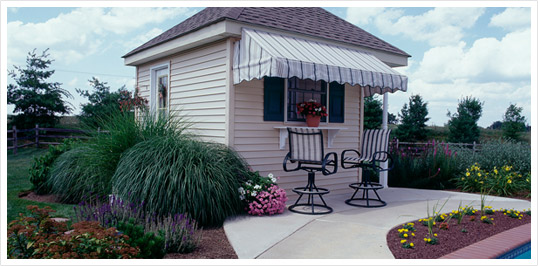|
|

|
|
|
|
| You CAN Paint Most Maintenance-Free Materials |
|
| March 08, 2012 - Painting |

|
|
(HIT) - We often hear how certain exterior building materials are maintenance-free. Once installed on your home, you can forget about them forever, the ads say. Vinyl siding, composite decking, fiberglass trim, and factory-finished aluminum are just some of the materials that fit the description.
But what if you want to paint them -- to change the color, freshen the appearance, or simply provide an extra layer of protection against the elements? Can you paint something that does't require painting?
"Most of the time, you can paint these materials," says Debbie Zimmer, paint and color expert at the Paint Quality Institute. "But it's important that you follow the right procedures when doing so."
As with other exterior paint jobs, it's important that you first make any repairs that are necessary, then thoroughly clean and rinse the surface before applying any type of coating, says Zimmer. If mildew is present, it must also be removed, using a 3:1 water/bleach solution, followed by a thorough rinsing.
Another thing: It's always wise to apply a coat of top quality acrylic latex primer when painting maintenance-free materials. A primer will help the paint get a better grip on the surface, and give the finished paint job more uniform color and sheen.
When it comes to the paint itself, it?'s important that you use the right product. Zimmer says that high quality 100% acrylic latex paint is a great choice for almost any type of exterior painting, but it's essential when painting surfaces that are designed to be maintenance-free, which often are very smooth and slick.
"Top quality 100% acrylic latex paint provides the best adhesion to virtually any material, it produces a very durable paint film, and it has very consistent color and gloss," says Zimmer. "By applying this type of paint, the surface will look great, and it will stay that way for years to come."
As is true with all painting, it's a good idea to apply the primer and paint with quality brushes and rollers. They'll help you put down thicker, more protective layers of the coatings, and enable you to get the best possible appearance with your new paint job.
A final tip: Apply the primer and paint on a moderate day - one that's not too hot, too cold, or too windy. Each of these weather extremes can have an adverse effect on any coating as it dries and cures, possibly compromising the integrity of the finished paint job. You can usually find specific temperature guidelines on the label of the paint can.
So, the next time you're wondering whether a material that is touted as maintenance-free can be painted, wonder no more: The answer is almost always 'yes'. To make sure, visit the Paint Quality Institute website at www.paintquality.com, where you'll also find detailed, step-by-step instructions on painting virtually any type of exterior or interior surface.
Courtesy: Home Improvement News and Information Center |
|
| |
|
|